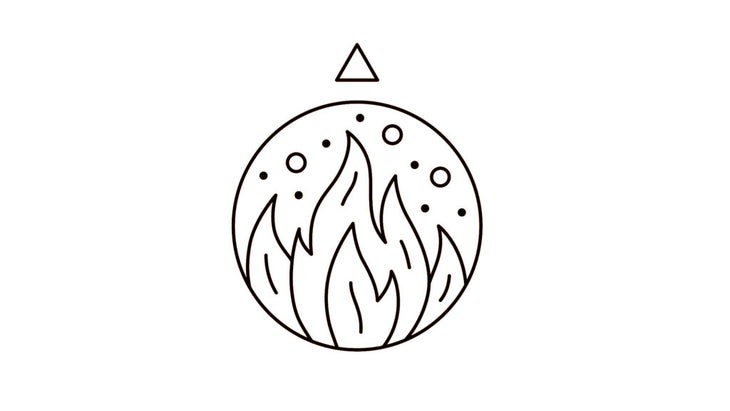“], “filter”: { “nextExceptions”: “img, blockquote, div”, “nextContainsExceptions”: “img, blockquote, a.btn, a.o-button”} }”>
Heading out the door? Read this article on the new Outside+ app available now on iOS devices for members!
>”,”name”:”in-content-cta”,”type”:”link”}}”>Download the app.
Millennials such as myself have been officially labeled “the most anxious generation.” According to the American Psychological Association, close to 12 percent of us born between 1981 and 1996 have been diagnosed with anxiety disorder. That’s more than double the average rate of boomers. Research suggests things aren’t looking any better for Gen Z.
Like you, I am not immune to life feeling largely out of control and being overwhelmed, even as a yoga teacher. Although the default for many of us is Googling “how to deal with anxiety,” there is also centuries-old wisdom that can offer temporary relief and a lasting understanding of what might be contributing to our emotional intensity.
Ayurveda, the sister science to yoga, teaches that we each have a lens through which we experience the world. When we understand that we see things through a filter, we can begin to understand how to quiet our anxiety.
Ayurveda for Anxiety Archetypes
Ayurveda considers all living things on our planet, including humans, to be a unique balance of the five elements, including earth, water, fire, air, and ether (space). These elements are present in varying amounts in each of us and comprise create three basic categories, known as doshas:
Kapha
Earth and water
Pitta
Water and fire
Vata
Air and ether
Each human is predisposed to having a single dominant dosha that becomes the lens through which you filter each experience, sensation, and emotion. It prevails in your physical body, your thoughts and how you process experiences, and your personality. (There are online quizzes that can help you determine your primary dosha.)
The other doshas remain present in varying degrees. The challenge becomes navigating life in a state of relative balance among these different ways of perceiving and reacting. According to Ayurveda, “like attracts like.” That means we often reach for the same activities that feel familiar and comfortable to our dosha.
Those with a predominance of vata are typically drawn to experiences that have the qualities of air and ether elements, such as raw food, quick movements, and overthinking. Pitta-predominant people tend to veer toward fiery things, such as hot yoga, spicy foods, and frustrated rants. And those with ample kapha prefer grounding experiences, such as restorative yoga and hours spent reading.
The tendency to return to our patterned traits is especially common in times of emotional overwhelm, such as when we experience anxiety. The problem, according to Ayurveda, is this behavior perpetuates an already existing imbalance, which can further exacerbate an inability to come back to a state of calm.
But if our tendencies to flood one predominant dosha can draw us out of balance, then engaging in the opposite behavior can bring us back to equilibrium. Following are some common ways that anxiety presents itself and what you can do to help quiet it, according to Ayurveda.
1. Kapha
A kapha personality is a combination of the qualities of earth and water. These lend themselves to stability and cohesion, making kapha individuals steady and strong.
Anxiety can manifest in kapha as an excess of feelings of heaviness, depression, and inability to create or invite change. These individuals, under duress, often experience the freeze response of the nervous system and may be so anxious about the overwhelming demands of the world that they essentially shut down and no longer engage at all. Instead, they may end up endlessly watching Netflix, reading a novel, or scrolling through social media.
Someone experiencing this sort of anxiety could benefit from increasing their inner fire. That looks like dispersing the heat by taking a walk or engaging in a slow vinyasa practice. Engaging in heat-building breathwork can also help. When it seems impossible to summon motivation from within, simply sitting outside in the sun can make a profound difference.

2. Pitta
A pitta personality is a combination of tumultuous water and fire. When in balance, pitta people tend to be exuberant and self-proclaimed “Type A” workers and leaders who love to multitask. Their internal heat and drive make them intense workers and dedicated fighters for a cause who can be relied upon to get things done no matter what.
People with more pitta tend to be able to withstand a tremendous amount of stress. However, an unchecked pitta personality in the midst of compounded or prolonged stressors, such as financial frustration and fear, can experience an excess of heat. This tends to be channeled into irritability and frustration.
When they experience anxiety, pitta tend to feel frustration and anger in response to an assumption that their best intentions were thwarted either by others or circumstances. They may blame or judge others—and, more than likely, themselves—for past mistakes that have led them to this place in life where nothing seems to go their way.
Someone experiencing pitta-induced anxiety can be irritable with their loved ones, creating a vicious cycle of self-deprecation and passive-aggressive lashing out. (My pitta anxiety tends to manifest as a fiery vengeance each time my husband leaves an empty snack wrapper on the kitchen counter, as if it’s responsible for all that is wrong in my life.)
To calm the fiery pitta-induced anxiety, take a break from demanding physical practices and find opportunities to slow down. This resets the nervous system and balances the excess intensity. In the sweltering heat of summer when pitta heat is already running high, consider replacing your afternoon run with an evening walk. Rather than take a hot yoga class, try a yin yoga stretching class. Explore some meditative and mindfulness techniques that remind you to slow down and pause. Head to the beach or a lake in the woods for the weekend. Try cooling breathing techniques that can reset the body and mind.
By looking for places to minimize intensity in your life, you can more easily withstand the parts of your day that aren’t within your control.

3. Vata
A vata personality is a combination of air and ether. When in balance, vata are creative and easy to get along with. They tend to go with the flow and simply readjust when a problem arises.
When in the throes of anxiety, however, vata feels at the whim of air and ether, as if the wind is tossing them in all directions at once. It can feel impossible to settle or calm down with their nervous system in overdrive. They might skip from thought to thought, find themselves unable to remember or finish anything, distract themselves by ruminating on their fears of the future, and lack the bandwidth to connect with loved ones.
A person in the throes of vata-induced anxiety may not be helped by vigorous exercising, yet it is the vata-driven individuals who typically choose to soothe their discomfort through fast-moving activities such as a vinyasa class or running. These can leave the vata-predominant individual feeling even more depleted and disconnected.
To ground the experience of an airy vata anxiety, look for ways to incorporate more earth energy. Opt for grounding techniques, such as slowing down and practicing yin or restorative yoga and engaging in self-massage with oil. Try eating root vegetables or sipping warm teas or soups to imbue your body with warmth and earth from the inside-out. Meditating and creating time for rest can greatly benefit those living with an imbalance of vata.
What Happens When Your Anxiety Remains Unchecked
All things in life exist on a spectrum. Because our energies are constantly in flux, anyone can move through each of these archetypes of anxiety at any time, even though we have a default dosha. When left unchecked over time, one dosha’s imbalance response to anxiety can easily lead to an imbalance in another dosha. As a result, the expression of anxiety changes.
For example, if you experience vata or airy anxiety, you can become so expended that you collapse into a kapha state of depletion, as if the winds of a tornado have flattened your house, leaving nothing left.
A pitta or fiery anxiety can essentially “burn the house down,” leaving you with nothing but ash. When the winds of change inevitably take place, you might find yourself swept up in vata-induced anxiety.
A kapha or earthy anxiety might land you so inertly in your bed that you start to feel like you’re missing out on life. You might emerge with intense anger and resentment, swinging the pendulum the other direction into pitta anxiety as you push harder and harder to be able to function in your essential everyday responsibilities.
Understanding this and becoming aware of your energies and moods as they fluctuate can help you begin to apply techniques that draw you back into some semblance of balance.
How Ayurveda for Anxiety Can Help
Everything we experience in everyday life contributes to the balance—or imbalance—of elements in our bodies and minds. That includes our activities, our relationships, even the way we eat. Finding balance among these energies in relation to our own unique constitution can help us better understand what pulls us out of balance.
However, there is a universal truth for all personalities. When anxiety does flare, you can slow your breath, place one hand on your abdomen and the other on your heart, and ground yourself in the moment by focusing on the sensations in your physical body. Try to simply focus on the movement of your breath. When you can allow your anxiety to take a backseat long enough, it becomes easier to remember who you are. That helps you remember to turn to the other tactics that bring you ease.












